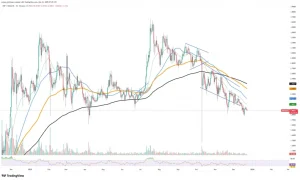Bitcoin Faces Volatility as Long-Term Holders Liquidate Rs. 3.7 Lakh Crore Worth of Assets

Bitcoin’s market stability has been rattled after long-term holders offloaded nearly 400,000 BTC, valued at approximately US $45 billion (≈ Rs. 3.7 lakh crore). This large-scale liquidation marks one of the biggest sell-offs in recent months and has driven Bitcoin’s value down by more than 20% from its peak. Unlike prior downturns triggered by leveraged trading collapses, this phase stems largely from seasoned investors deliberately cashing out, signaling a deeper sentiment shift. The development has intensified concerns that the world’s largest cryptocurrency could be entering a consolidation period rather than an immediate recovery phase.
1. Major Sell-Off Signals Changing Market Psychology
The cryptocurrency landscape witnessed a sharp downturn as long-term Bitcoin holders—often referred to as “whales”—unloaded a massive portion of their holdings. Analysts estimate that over 400,000 BTC, previously dormant for months, entered the market between late October and early November.
This wave of distribution differs from previous market corrections typically triggered by leveraged liquidations. The recent sell-off represents strategic exits by large holders, many of whom are believed to be locking in profits from earlier price surges. Such a move indicates that investor conviction may be softening, replacing speculative optimism with a cautious, profit-oriented approach.
2. Price Impact: Bitcoin Falls Below Key Thresholds
The liquidation triggered immediate price pressure. Bitcoin slipped below US $100,000 for the first time since June, reflecting a loss of more than 7% in a single trading session and over 20% from its monthly high. The correction is notable because it was not accompanied by a surge in margin calls or leveraged blowouts, suggesting that the selling activity was deliberate rather than panic-driven.
Experts warn that the renewed volatility could extend into the coming weeks if the market fails to absorb the excess supply. Meanwhile, investor sentiment appears to be turning defensive, with shorter holding periods and lower inflows into spot exchanges.
3. Spot Market Pressure Replaces Leverage Crashes
Historically, Bitcoin’s largest corrections have stemmed from the cascading effect of futures market liquidations, where excessive leverage forced traders to exit en masse. This time, however, the data points to spot market stress, reflecting decisions by experienced holders rather than leveraged speculators.
The reduced volume of futures liquidations—approximately US $2 billion compared with nearly US $19 billion in previous cycles—underscores this structural change. Analysts interpret this as evidence of an evolving market, one increasingly influenced by long-term capital flows rather than short-term speculative trades.
4. Institutional Demand and Market Absorption Challenges
Despite the selling spree, institutional buying has not accelerated fast enough to counterbalance the new supply. Exchange-traded products and digital asset funds saw tepid inflows, while retail participation weakened amid macroeconomic uncertainty.
With limited fresh capital entering the market, the supply-demand imbalance may continue to pressure prices. Some market strategists believe that institutional investors could re-enter at lower price levels, potentially stabilizing Bitcoin near the US $85,000–US $95,000 range. Until then, market conditions may remain volatile and range-bound.
5. Broader Implications: A Test of Market Maturity
This episode underscores how Bitcoin’s market is transitioning from a speculative growth phase to a more mature financial asset class. The selling by veteran holders may reflect portfolio rebalancing or profit realization, rather than loss of faith in the asset’s fundamentals.
However, it also highlights Bitcoin’s increasing sensitivity to broader macroeconomic forces—rising interest rates, regulatory tightening, and liquidity constraints in global markets. In this context, Bitcoin is behaving more like a high-risk investment asset than a pure store of value, challenging narratives of its detachment from traditional financial systems.
6. What Lies Ahead: Correction or Consolidation?
Market analysts remain divided on Bitcoin’s next move. Some foresee a prolonged consolidation phase, during which prices could fluctuate between US $85,000 and US $110,000 as investor sentiment resets. Others argue that the correction presents a long-term buying opportunity for those with a multi-year horizon.
If fresh institutional inflows resume and retail confidence returns, Bitcoin could reclaim its prior highs. However, absent such catalysts, the cryptocurrency may continue to experience sideways movement and lower volatility, characteristic of a maturing asset class.
Conclusion
The recent Rs. 3.7 lakh crore sell-off by Bitcoin’s long-term holders represents a critical juncture for the digital asset market. It reflects not only profit-taking behavior but also a fundamental shift toward a more measured, institutionally driven environment. Whether this signals the start of a deeper downturn or a healthy phase of consolidation, one thing is clear: Bitcoin’s evolution into a mature financial instrument will test both its resilience and the patience of its investors.




